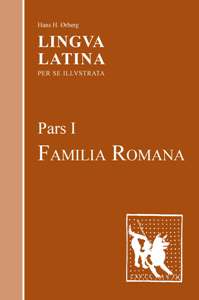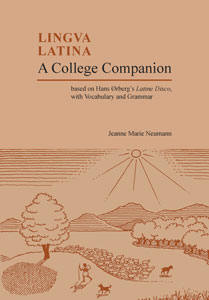

Lingua Latina
by Hans H. Orberg
Reviewed by Martha Robinson
Purchase details: Lingua Latina by Hans H. Orberg. Familia Romana, First Year Series reviewed. Prices shown in text below. Published by Focus Publishing. Please support HomeschoolChristian.com by buying these books using our Amazon affiliate link.
Lingua Latina is an immersion program. Using inductive reasoning, the student figures out Latin himself. By seeing examples in the text of Latin verb endings and sentence structure, for example, he forms a conclusion as to how Latin works. The author, Hans H. Orberg, is a Danish linguist and teacher who began this method of "natural" teaching in the 1950's.
Pars I: Familia Romana (paperback, 328 pages, $21) is the text book. It consists of thirty-five lessons written completely in Latin with many black-and-white illustrations and copious margin notes that include vocabulary (some defined by a line drawing), verb forms, declension endings, and other explanatory information. Each chapter has three sets of exercises, Pensum, that cover grammar, vocabulary, and composition. The final chapter is a sort of Latin grammar catechism with questions and answers. A vocabulary index is at the back of the text, and when students have forgotten a word previously introduced, they are told to find it with the index and surmise its meaning again from the context of the story.
Homeschooling families have a choice of guides to help learn Lingua Latina. The first is Latine Disco (staple-bound paperback, 50 pages, $6), the student's manual for the program. This book, written in tiny print, begins with an introduction to Latin and its pronunciation. It then overviews the Lingua Latina program and its components and proceeds with chapter by chapter "instructions." These instructions actually consist of highlights pointed out from the text and hints that allow the student to understand the grammatical concepts or vocabulary better. Latine Disco is the key to using this program inductively. Enough information is provided for the student to draw conclusions, but not so much information that it seems to be actively teaching.
The second choice for a program guide is Lingua Latina: A College Companion. (Paperback, 348 pages, $24.95) This book was actually written to teach the entire text in two semesters of college at a rapid pace. Points of grammar and vocabulary are spelled out, and a brief summary of each chapter is provided in English. The introduction points out that this book takes away from the inductive approach, but works better for those students who prefer a more traditional method. Busy homeschooling parents who are not Latin experts will find this book extremely helpful as a teaching aid, because they will not have to figure everything out in order to help their student.
Speaking Latin conversationally is a key component to Lingua Latina. Colloquia Personarum (Paperback, 78 pages, $10.95) is a book of conversations in Latin, generally with two or three participants. The point of this resource is to reinforce the vocabulary and grammar taught in the lesson. Homeschooling families can have some fun acting out these twenty-four mini-dramas.
Exercitia Latina (Paperback, 137 pages, $12.95) is a workbook with fill-in-the-blank exercises to reinforce grammar concepts. Each chapter has one hundred or more sentences to work with. Vocabulary applicable to the lesson and notes such as conjugation and declension endings appear in the margins to help the student with this "homework." Answers are in the Teacher's Materials and Answer Keys.
Latine Doceo: A Companion for Instructors (Paperback, 62 pages, $18.95) explains the philosophy behind Lingua Latina and how Hans H. Orberg's method is better than the standard "grammar/translation" method. The authors discuss the benefits of studying Latin and the importance of being diligent in order to be successful. The included explanation of all of the Lingua Latina materials provides teachers and parents with information to help them decide how to implement the program. The majority of the book has instructor's notes to enhance the Latine Disco student book. The authors offer that these notes will be very helpful, but might confuse the student if included in Latine Disco.
Latin-English Vocabulary I (staple-bound pamphlet, 19 pages, $2) is a quick reference for translating words found in the text. The author does not recommend using this unless the student is unsure and cannot figure out the word using the context of the story.
Colloquia Personarum Latin-English Vocabulary (staple-bound pamphlet, 12 pages, $2) is the quick reference for Colloquia Personarum. Again, the author suggests that the student use this only as a last resort if unsure about the meaning of a word taken in context.
The Teacher's Materials and Answer Keys include the pensum questions from the end of each chapter (capitulum) in the text for the convenience of the teacher. The answers are in the back of the book. The key for Exercitia Latina is also included in the Teacher's Materials.
The Grammatica Latina I (staple-bound paperback, 32 pages, $6) is a reference of all grammar concepts covered in Pars I: Familia Romana. The included information is only to be covered and memorized after it has been introduced and its meaning ascertained via the text. All declensions and conjugations are taught in this curriculum.
After completion of Pars I: Familia Romana, the author recommends continuing with Part II of the program, Roma Aeterna. Alternatively, he suggests Latin readers written in the same manner such as Aeneis (The Aeneid) or Cena Trimalchionis.
Recommendation: Lingua Latina uses a proven method for learning and retaining a foreign language: inductive immersion. Ecce Romani is probably more familiar to homeschooling families, and Lingua Latina, the original Latin curriculum to use this method, is similar; however, Lingua Latina is written at a more challenging level, uses only line drawings, and has no English in the text.
Parents may be confused by the tremendous number of books that are part of Lingua Latina. They will definitely need to purchase the text, Pars I: Familia Romana and the student guide, Latine Disco. If the parent has time and available thought processes to study diligently with the student, the two books will suffice, but if she is like most busy homeschooling parents, she should invest in the Lingua Latina: A College Companion so she can easily discover what the lesson is conveying. For the best results, the parent should also purchase the Exercitia Latina, Teacher's Materials and Answer Keys, and the Colloquia Personarum.
Lingua Latina will be an excellent choice for a high school student or a very motivated junior high student who enjoys figuring out the answers. The program is set up for the student to work at his own pace, and two high school credits may be awarded (equivalent to two college semesters) upon successful completion. Interested parents can easily work along with their students.
HomeschoolChristian.com resources related to this review:
Latin Curricula Comparison Chart to help select an introductory or intensive program.
Lingua Latina Interactive Latin Course I
Living With Latin at Home
Studying Latin
Latin-Based Education, an interview with Cheryl Lowe
Reviews represent the opinions of the authors rather than the views of HomeschoolChristian.com.



